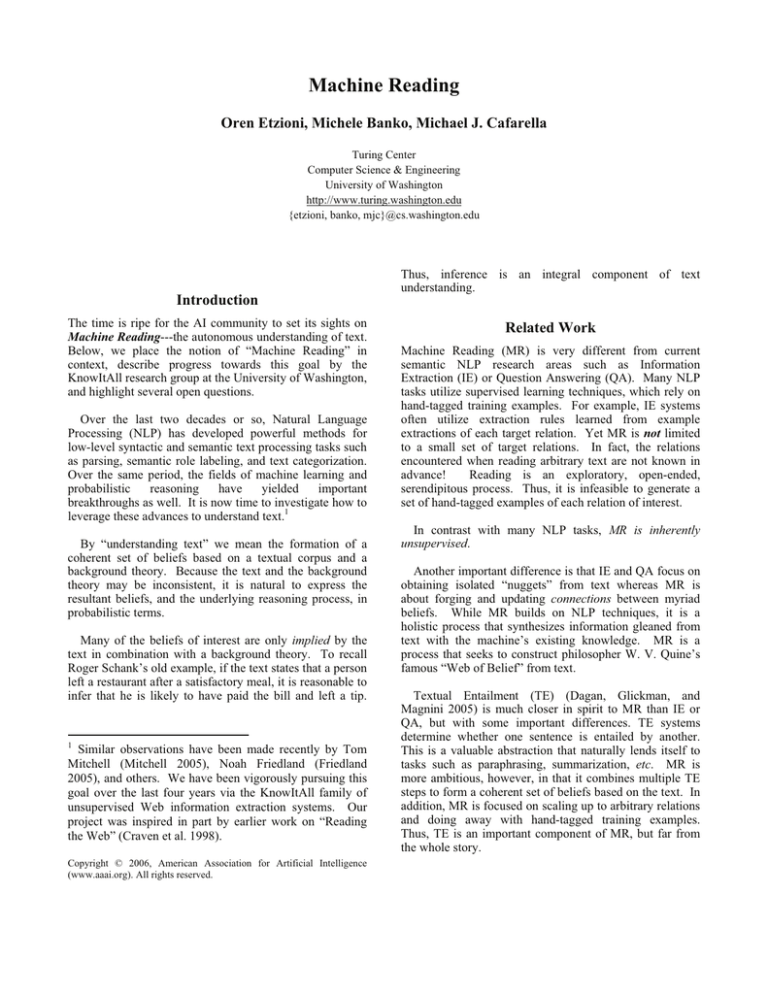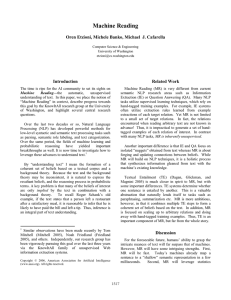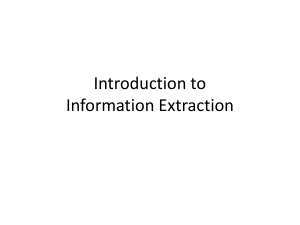
Machine Reading
Oren Etzioni, Michele Banko, Michael J. Cafarella
Turing Center
Computer Science & Engineering
University of Washington
http://www.turing.washington.edu
{etzioni, banko, mjc}@cs.washington.edu
Thus, inference is an integral component of text
understanding.
Introduction
The time is ripe for the AI community to set its sights on
Machine Reading---the autonomous understanding of text.
Below, we place the notion of “Machine Reading” in
context, describe progress towards this goal by the
KnowItAll research group at the University of Washington,
and highlight several open questions.
Over the last two decades or so, Natural Language
Processing (NLP) has developed powerful methods for
low-level syntactic and semantic text processing tasks such
as parsing, semantic role labeling, and text categorization.
Over the same period, the fields of machine learning and
probabilistic
reasoning
have
yielded
important
breakthroughs as well. It is now time to investigate how to
leverage these advances to understand text.1
By “understanding text” we mean the formation of a
coherent set of beliefs based on a textual corpus and a
background theory. Because the text and the background
theory may be inconsistent, it is natural to express the
resultant beliefs, and the underlying reasoning process, in
probabilistic terms.
Many of the beliefs of interest are only implied by the
text in combination with a background theory. To recall
Roger Schank’s old example, if the text states that a person
left a restaurant after a satisfactory meal, it is reasonable to
infer that he is likely to have paid the bill and left a tip.
1
Similar observations have been made recently by Tom
Mitchell (Mitchell 2005), Noah Friedland (Friedland
2005), and others. We have been vigorously pursuing this
goal over the last four years via the KnowItAll family of
unsupervised Web information extraction systems. Our
project was inspired in part by earlier work on “Reading
the Web” (Craven et al. 1998).
Copyright © 2006, American Association for Artificial Intelligence
(www.aaai.org). All rights reserved.
Related Work
Machine Reading (MR) is very different from current
semantic NLP research areas such as Information
Extraction (IE) or Question Answering (QA). Many NLP
tasks utilize supervised learning techniques, which rely on
hand-tagged training examples. For example, IE systems
often utilize extraction rules learned from example
extractions of each target relation. Yet MR is not limited
to a small set of target relations. In fact, the relations
encountered when reading arbitrary text are not known in
advance!
Reading is an exploratory, open-ended,
serendipitous process. Thus, it is infeasible to generate a
set of hand-tagged examples of each relation of interest.
In contrast with many NLP tasks, MR is inherently
unsupervised.
Another important difference is that IE and QA focus on
obtaining isolated “nuggets” from text whereas MR is
about forging and updating connections between myriad
beliefs. While MR builds on NLP techniques, it is a
holistic process that synthesizes information gleaned from
text with the machine’s existing knowledge. MR is a
process that seeks to construct philosopher W. V. Quine’s
famous “Web of Belief” from text.
Textual Entailment (TE) (Dagan, Glickman, and
Magnini 2005) is much closer in spirit to MR than IE or
QA, but with some important differences. TE systems
determine whether one sentence is entailed by another.
This is a valuable abstraction that naturally lends itself to
tasks such as paraphrasing, summarization, etc. MR is
more ambitious, however, in that it combines multiple TE
steps to form a coherent set of beliefs based on the text. In
addition, MR is focused on scaling up to arbitrary relations
and doing away with hand-tagged training examples.
Thus, TE is an important component of MR, but far from
the whole story.
Discussion
For the foreseeable future, humans’ ability to grasp the
intricate nuances of text will far surpass that of machines.
However, MR will have some intriguing strengths. First,
MR will be fast. Today’s machines already map a
sentence to a “shallow” semantic representation in a few
milliseconds.
Second, MR will leverage statistics
computed over massive corpora. For example, Peter
Turney (Turney 2002) has shown how mutual-information
statistics, computed over the Web corpus, can be used to
classify opinion words as positive or negative with high
accuracy.
These observations suggest a loose analogy between
Machine Reading and Computer Chess. The computer’s
approach to playing chess is very different than that of a
person. Each player, human or computer, builds on their
own “natural” strengths. A computer’s ability to analyze
the nuances of a chess position (or a sentence) is far
weaker than that of a person, but the computer makes up
for this weakness with its superior memory and speed. Of
course, MR is an “ill-structured problem” that the
computer cannot solve by mere lookahead search.
However, we conjecture that MR, like computer chess, will
be “shallow” yet lightning fast. Furthermore, MR’s
development will be very different than the development of
human reading. As with Computer Chess, MR will build
on the machine’s strengths in memory and speed. Table 1
contrasts human reading versus the state-of-the-art in MR
today.
Human Reading
Machine Reading
High precision
Broad scope
Sentence-by-sentence
High comprehension
Background Knowledge.
Single language
Slow
Noisy
Limited scope
Corpus-wide statistics
Minimal reasoning
Bottom up
General
Very Fast!
Table 1: Human reading and Machine Reading (MR) side-byside. Despite being much weaker than human reading, MR
already exhibits some intriguing capabilities, shown in bold
above.
Initial Steps towards Machine Reading
Numerous preliminary attempts at text understanding can
be found in the field of Information extraction (IE). IE has
traditionally relied on extensive human involvement to
identify instances of a small, predefined set of relations,
but a recent goal of modern information extraction has
been to reduce the amount of human participation involved
when extending to a new domain or set of relations.
An important step in this direction was the training of IE
systems using hand-tagged training examples. When the
examples are fed to machine learning methods, domainspecific extraction patterns can be automatically learned
and used to extract facts from text. However, the
development of suitable training data requires a non-trivial
amount of effort and expertise.
DIPRE (Brin 1998) and Snowball (Agichtein 2000)
further demonstrated the power of trainable information
extraction systems by reducing the amount of manual labor
necessary to perform relation-specific extraction. Rather
than demand hand-tagged corpora, these systems required
a user to specify relation-specific knowledge in the form of
a small set of seed instances known to satisfy the relation
of interest or a set of hand-constructed extraction patterns
to begin the training process.
The KnowItAll Web IE system (Etzioni et al. 2005) took
the next step in automation by learning to label its own
training examples using only a small set of domainindependent extraction patterns, thus being the first
published system to carry out unsupervised, domainindependent, large-scale extraction from Web pages.
For a given relation, these generic patterns were used to
automatically instantiate relation-specific extraction rules,
which were then used to learn domain-specific extraction
rules. The rules were applied to Web pages, identified via
search-engine queries, and the resulting extractions were
assigned a probability using mutual-information measures
derived from search engine hit counts. For example,
KnowItAll utilized generic extraction patterns like
“<Class> such as <Mem>” to suggest instantiations of
<Mem> as candidate members of the class. Next,
KnowItAll used frequency information to identify which
instantiations are most likely to be bona-fide members of
the class. Thus, it was able to confidently label New York,
Paris, and London as members of the class “Cities”
(Downey, Etzioni, and Soderland 2005).
Finally,
KnowItAll learned a set of relation-specific extraction
patterns (e.g. “headquartered in <city>”) that led it to
extract additional cities and so on.
KnowItAll is self supervised---instead of utilizing handtagged training data, the systems select and label their own
training examples, and iteratively bootstrap their learning
process.
Self-supervised systems are a species of
unsupervised systems because they require no hand-tagged
training examples whatsoever. However, unlike classical
unsupervised systems (e.g., clustering) self-supervised
systems do utilize labeled examples and do form classifiers
whose accuracy can be measured using standard metrics.
Figure 1: A sample screen shot of TextRunner in response to the query “invented” as a predicate. While the
results are informative, they are far from perfect. However, they demonstrate TextRunner’s ability to extract a
wide range of information from arbitrary Web text.
Instead of relying on hand-tagged data, self-supervised
systems autonomously “roll their own” labeled examples.
While self-supervised, KnowItAll is relation-specific--it requires a laborious bootstrapping process for each
relation of interest, and the set of relations of interest has to
be named by the human user in advance. This is a
significant obstacle to MR because during reading one
often encounters unanticipated concepts and relations of
interest.
Open Information Extraction
This limitation led us to develop Open Information
Extraction (Open IE)---a novel extraction paradigm that
facilitates domain-independent discovery of relations
extracted from text and readily scales to the diversity and
size of the Web corpus. The sole input to an Open IE
system is a corpus, and its output is a set of extracted
relations. An Open IE system makes a single pass over its
corpus guaranteeing scalability with the size of its corpus.
TextRunner (Banko, Cafarella, and Etzioni 2007) is a
fully implemented Open IE system that seamlessly extracts
information from each sentence it encounters. Instead of
requiring relations to be specified in its input, TextRunner
learns the relations, classes, and entities from the text in its
corpus in a self-supervised fashion.2
TextRunner extraction module reads in sentences and
rapidly extracts one or more textual triples that aim to
capture (some of) the relationships in each sentence. For
example, given the sentence “Berkeley hired Robert
Oppenheimer to create a new school of theoretical
physics”, the extractor forms the triple (Berkeley, hired,
Robert Oppenheimer). The triple consists of three strings
where the first and third are meant to denote entities and
the intermediate string is meant to denote the relationship
between them. There are many subtleties to doing this
kind of extraction with good recall and precision, but we
will not discuss them here.
2
To get a sense of TextRunner’s capabilities, visit
http://www.cs.washington.edu/research/textrunner.
TextRunner indexes all of its triples in Lucene, which
enables it to rapidly answer queries regarding the extracted
information. See Figure 1 for a sample result page.
Due to the myriad ways in which facts are asserted in
massive corpora such as the Web, the problem of
synonymy is particularly acute for TextRunner both in the
case of multiple names for the same entity and in the case
of multiple ways denoting a relationship between two
entities. We refer to the union of both problems as
Synonym Resolution.
Previous techniques for synonym resolution have
focused on one particular aspect of the problem, either
objects or relations. In addition, the techniques either
depend on a large set of hand-tagged training examples, or
are tailored to a specific domain by assuming knowledge
of the domain’s schema which is not available in the
context of Open IE
To address synonym resolution for Open IE, we
developed Resolver, a scalable, domain-independent,
unsupervised synonym resolution system that applies to
both objects and relations (Yates and Etzioni, 2007).
Resolver introduces a probabilistic relational model for
predicting whether two strings are co-referential based on
the similarity of the assertions containing them.
In
preliminary experiments over TextRunner extractions,
Resolver achieved impressive precision (0.9 for relation
synonymy, and 0.74 for objects) at acceptable levels of
recall. Details of the algorithms and the experiments are in
(Yates and Etzioni, 2007).
TextRunner operates at very large scale. In a recent run,
it processed 110,000,000 Web pages yielding over
330,000,000 extractions with an estimated precision of
close to 90% on concrete extractions.3
Clearly,
TextRunner is an early embodiment of the idea that MR
will be fast but shallow.
While TextRunner is a state-of-the-art IE system, its
ability to read is very primitive. Its value is in showing
that NLP techniques can be harnessed to begin to
understand text in a domain-independent and unsupervised
manner. We are now working on composing TextRunner
extractions into coherent probabilistic theories, and on
forming generalizations based on extracted assertions.
3
Concrete extractions are ones whose arguments refer to
particular entities or classes. For example, an extracted
triple where both arguments are proper nouns is concrete,
but so is the extraction that tells us that Lycopene is an
antioxidant. In contrast, an abstract extraction is one that
describes general properties of classes such as “pedestrians
cross streets”. See Figure 2 for a breakdown of a large
sample of TextRunner extractions.
Triples
11.3 million
With Well-Formed Relation
9.3 million
With Well-Formed Entities
7.8 million
Abstract
6.8 million
79.2% correct
Concrete
6.8 million
88.1%
correct
Figure 2: A sample of 11,300,000 assertions extracted by
TextRunner from Web text. This Venn diagram depicts the
fraction of triples extracted that are useful, and the precision of
both concrete and abstract extractions. TextRunner’s efficient
querying capability enables us to home in on a particular set of
extractions.
For example, querying TextRunner with the
predicate “invented” yields a large number of triples denoting
inventors and their inventions.
TextRunner is at
http://www.cs.washington.edu/research/textrunner.
Conclusion
We have argued that the time is ripe for Machine Reading
to join Machine Learning and Machine Translation as a
full-fledged field of AI research. We have described
several initial steps in this direction, but numerous open
problems remain.
One open problem worth highlighting is recursive
learning---how can an MR system leverage the
information it has read to date to enhance its understanding
of the next sentences it encounters? Humans become
exponentially more proficient at a task as they practice it--can we develop MR systems that exhibit some of that
amazing learning capability?
In conclusion, Machine Reading is an ambitious
undertaking but the pieces of the puzzle are at hand, and
the payoff could lead to a solution to AI’s infamous
knowledge acquisition bottleneck.
Acknowledgements
This research was supported in part by NSF grant IIS0312988, DARPA contract NBCHD030010, ONR grant
N00014-05-1-0185 as well as a gift from Google. Thanks
go to Dan Weld for helpful comments on a previous draft,
and to all members of the KnowItAll Research Group for
their insights and contributions. This work was performed
at the University of Washington’s Turing Center.
References
Agichtein, E., and Gravano, L. 2000. Snowball: Extracting
Relations from Large Plain-Text Collections.
In
Proceedings of the Fifth ACM International Conference on
Digital Libraries, 85-94. San Antonio, TX: Association for
Computing Machinery.
Brin S. 1998. Extracting Patterns and Relations from the
World Wide Web. In Proceedings of the First International
Workshop on the Web and Databases, 172-183. Valencia,
Spain: World Wide Web and Databases International
Workshops.
Banko M., Cafarella M., and Etzioni O. 2007. Open
Information Extraction from the Web. In Proceedings of
the Twentieth International Joint Conference on Artificial
Intelligence. Hyderabad, India: International Joint
Conferences on Artificial Intelligence.
Craven, M., DiPasquo, D., Freitag, D., McCallum, A.K.,
Mitchell, T., Nigam, K., and Slattery, S. 1998. Learning to
Extract Symbolic Knowledge from the World Wide Web.
In Proceedings of the The Fifteenth National Conference
on Artificial Intelligence, 509-516. Madison, WI: AAAI
Press.
Dagan, I., Glickman, O., and Magnini, B. 2005. The
PASCAL Recognizing Textual Entailment Challenge. In
Proceedings of the First PASCAL Machine Learning
Challenges Workshop, 177-190. Southampton, United
Kingdom: Pattern Analysis, Statistical Modeling and
Computational Learning.
Downey, D., Etzioni, O., and Soderland, S. 2005. A
Probabilistic Model of Redundancy in Information
Extraction. In Proceedings of the Nineteenth International
Joint Conference on Artificial Intelligence, 1034-1041.
Edinburgh, Scotland: International Joint Conferences on
Artificial Intelligence.
Etzioni, O., Cafarella, M., Downey, D., Popescu, A.,
Shaked, T., Soderland, S., Weld, D. S., and Yates, A. 2005.
Unsupervised Named-Entity Extraction from the Web: An
Experimental Study. Artificial Intelligence 165(1):91-134.
Friedland, N. 2005. Personal Communication.
Mitchell, T. 2005. Reading the Web: A Breakthrough Goal
for AI. Celebrating Twenty-Five Years of AAAI: Notes
from the AAAI-05 and IAAI-05 Conferences. AI Magazine
26(3):12-16.
Turney, P. D. 2002. Thumbs up or thumbs down?
Semantic orientation applied to unsupervised classification
of reviews. In Proceedings of the 40th Annual Meeting of
the Association for Computational Linguistics, 417-424.
Philadelphia, PA: Association for Computational
Linguistics.
Yates, A., and Etzioni, O. 2007. Unsupervised Resolution
of Objects and Relations on the Web. In Proceedings of the
Human Language Technology Conference. Rochester, NY:
Association for Computational Linguistics.







